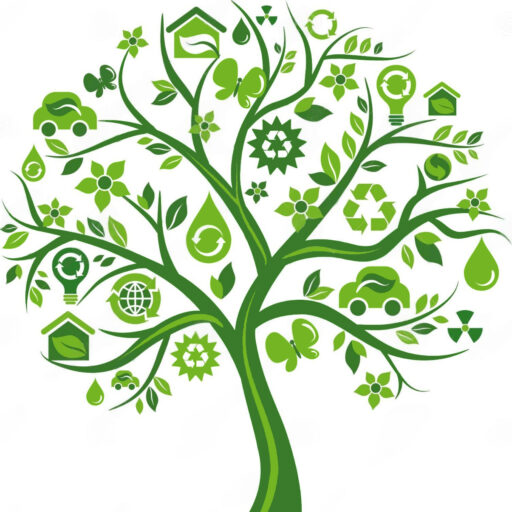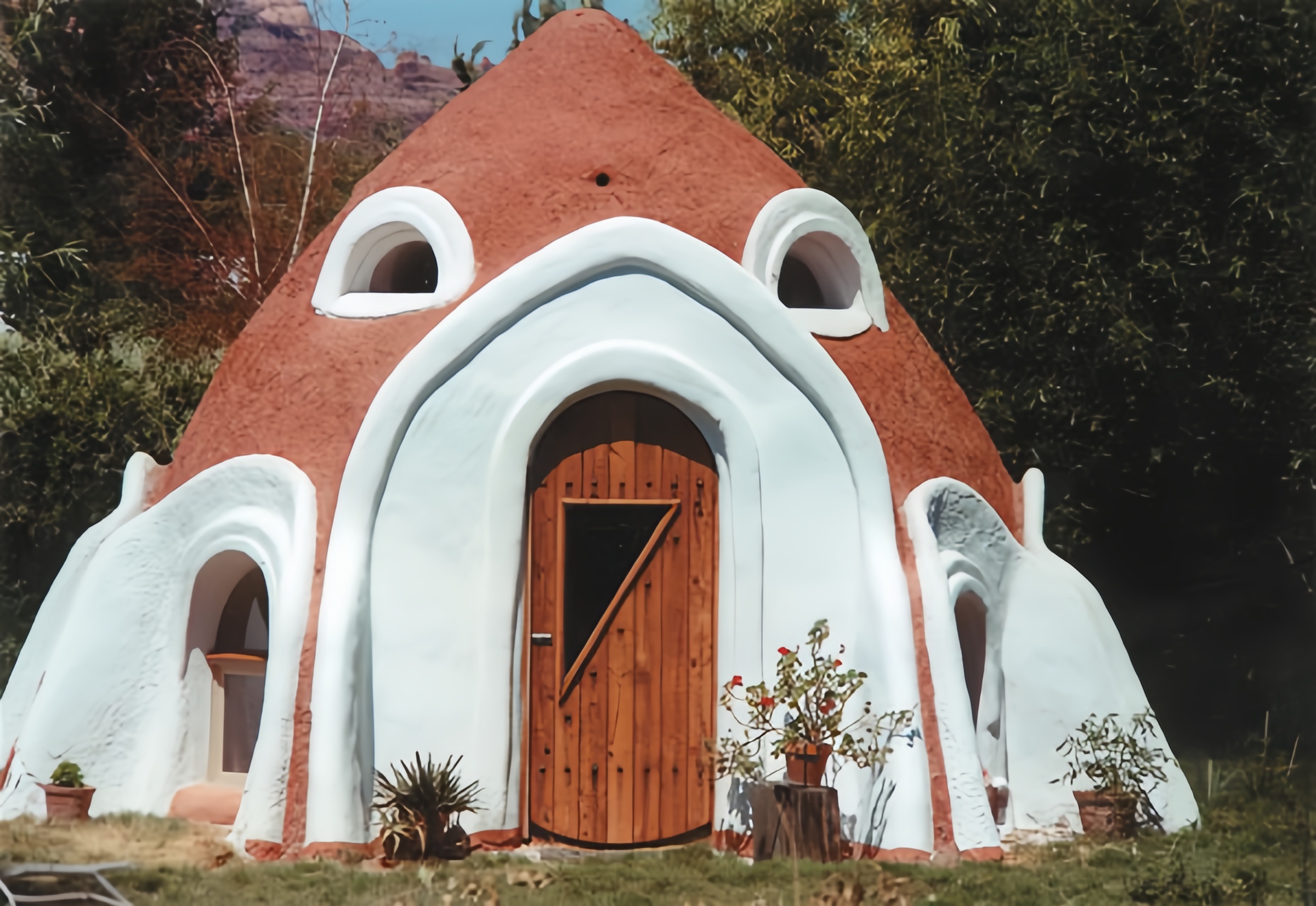Earthbag building is a new way that mixes old techniques with today’s green ideas. It’s a top choice for building eco-friendly homes. This method uses bags filled with natural stuff to make strong, lasting, and affordable buildings. It’s great for the planet because it uses less energy than traditional building materials like wood and steel.
Earthbag homes stay warm or cool, depending on the climate. They can stand up to bad weather and disasters like earthquakes and floods. You can use materials from around you, which saves money and cuts down on energy use. Plus, you can shape these buildings into domes, which means no need for a roof.
Building with earthbags is perfect for communities wanting affordable homes. You can use bags filled with gravel for foundations that are strong and don’t let moisture in. Polypropylene bags are even stronger and last longer. And plastering the bags adds extra protection, saving money and being good for the planet.
Key Takeaways
- Earthbag structures provide both thermal mass and insulation.
- They offer durability, being resistant to severe weather conditions and natural calamities.
- Construction is cost-effective as most materials can be sourced locally, and the bags are inexpensive.
- Earthbags can be shaped to form domes, eliminating the need for traditional roofing materials.
- The building process is accessible to unskilled labor, making it a feasible option for remote areas.
What is Earthbag Building?
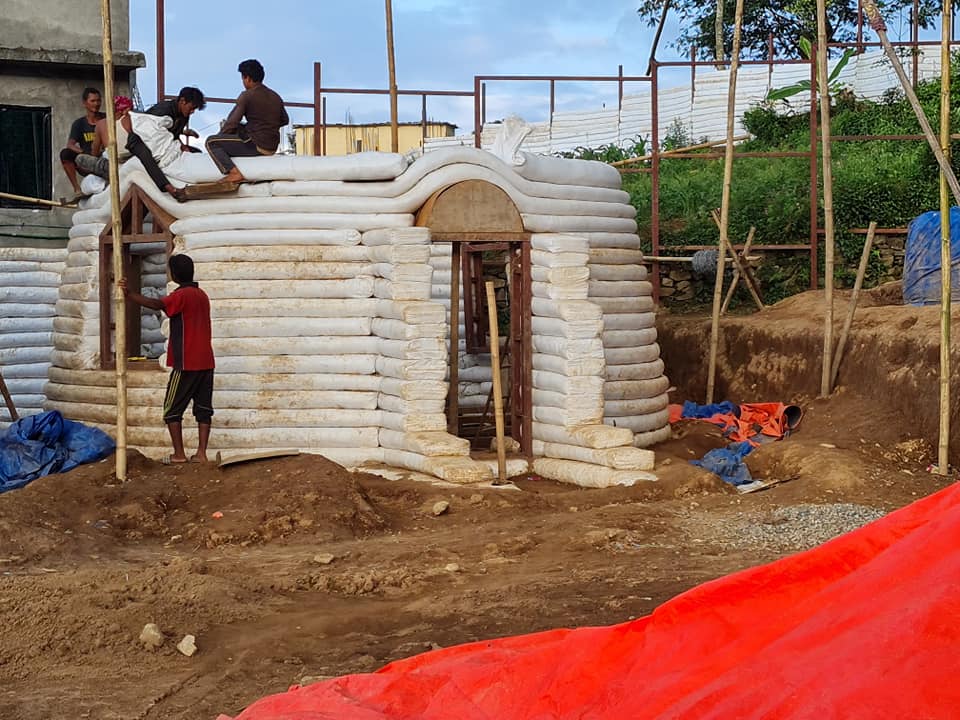
Earthbag building uses bags filled with materials like soil, gravel, or volcanic stone. It’s a green way to build homes that’s getting popular. People like it because it’s affordable, easy to make, and strong against disasters.
Definition and History
Earthbag building started with military use for building strong walls. Architect Nader Khalili made it popular for homes. It uses local materials, making it great for sustainable building.
By using materials found nearby, builders save money and help the planet. This method is smart and eco-friendly.
Advantages Over Traditional Construction
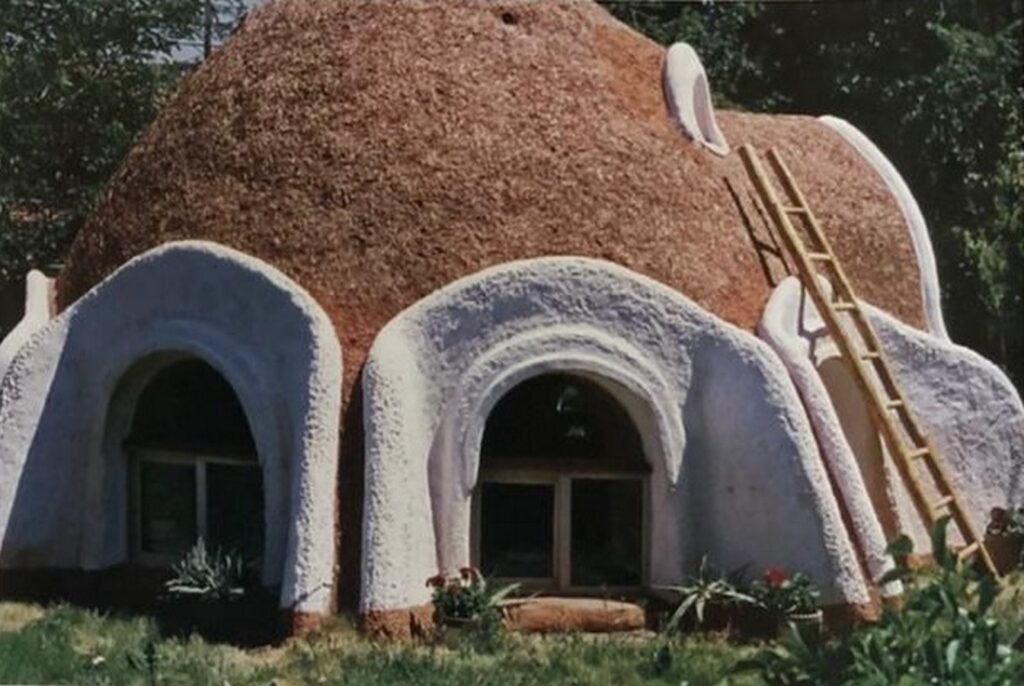
Earthbag buildings are strong against earthquakes and floods. They’re perfect for hot, dry places and areas with lots of shaking. Earthbag homes are also quicker and stronger than some other types of houses.
They’re shaped like circles, which makes them even more durable. This shape is great for roundhouses.
Building an earthbag house is cheaper than other methods. In Turkey, a roundhouse was made for about $5000 in 2012. Most of the cost was for labor, the roof, and the floorboards.
This house has lasted over 10 years, surviving many earthquakes. It shows how well earthbag building works.
There are some challenges, like making windows and doors, and applying plaster. But, earthbag building has many benefits. It’s a good choice for those wanting green and disaster-safe homes.
Materials Needed for Earthbag Building
Earthbag construction has changed sustainable architecture by using natural materials. It’s an affordable way to build strong structures with few resources. This method is great for eco-friendly homes.
Types of Bags
The key to earthbag building is the type of bag used. Most often, people use polypropylene and burlap bags. Polypropylene bags are top choice because they last long and handle sunlight well. Burlap bags are also used, often from recycled grain sacks. They’re cheap and good for the planet.
Filling Materials
The fill materials in earthbags affect the building’s strength and insulation. Sand, clay, and gravel are common choices, often found locally. For eco-friendly options, consider volcanic stone, perlite, vermiculite, or rice hulls. These materials make the structure strong against the elements.
Other Necessary Tools
To build an earthbag structure well, you’ll need certain tools. You’ll need wheelbarrows for moving materials, tools to pack the bags, and stands to keep them open. Guides help shape the structure right. For extra strength, use barbed wire, regular wire, and sometimes cement. Tools like the pulaski, sabre saw, and welded wire fabric are key for precise building.
Step-by-Step Guide to Earthbag Building
Earthbag building is popular for its simplicity, cost-effectiveness, and efficiency. This earthbag building guide will show you how to make a low-cost, eco-friendly home.
Foundation Preparation
Start your earthbag project with a strong foundation. A rubble trench foundation is often used. This means digging a trench and filling it with gravel bags to keep moisture out. These steps help make your structure stable and long-lasting:
- Excavate a trench that fits your wall’s size.
- Fill the trench with gravel bags to act as a moisture barrier.
- Make sure the base is level and packed down well.
Filling and Stacking Bags
Filling and stacking bags are key in the earthbag building guide. Use 2-gallon cement buckets to measure the fill for each bag. Here’s what to do next:
- Fill each bag about 90% to keep it even and save material.
- Put the filled bags in rows, and press each one for 1-2 minutes to pack it down.
- Use bags that are 18″ x 30″ to keep your walls stable.
Adding Barbed Wire Reinforcement
Adding barbed wire is important for earthbag building’s strength. Use two strands of 4-point barbed wire between each bag layer for extra support:
- Lay the first layer of filled bags.
- Put two strands of barbed wire along the bags’ length.
- Keep adding layers, making sure to put barbed wire between each one.
Constructing Doors and Windows
Adding doors and windows to earthbag buildings needs special steps:
- Put wooden anchors in the wall for door and window frames.
- Use custom-sized bags to fill any odd spaces, making sure there are no gaps.
- Use a sheet metal slider to help place each bag correctly around doors and windows.
Building with earthbags is efficient and can be a low-cost housing option. For example, a 625 square foot house can be built in 5-10 days with a few friends. Earthbag building supports sustainable architecture and community projects.
The Benefits of Using Natural Building Materials
Choosing natural building materials for eco-friendly homes has many benefits. These materials are good for the environment, cost-effective, and support health. They help make buildings strong and sustainable.
Environmental Impact
Natural building materials greatly reduce the harm to the environment. Using local resources cuts down on energy use and carbon emissions. Earthbag buildings don’t need energy-heavy products, supporting sustainable building.
They can last for hundreds of years with the right care. This makes them a lasting solution that helps protect the environment.
Cost-Effectiveness
Natural building materials are also cost-effective. Many can be found for free or at a lower price than traditional materials. For example, building a 1,250 sq. ft. earthbag home costs about $35,000.
This makes sustainable architecture more accessible. The building process is simple, reducing labor costs. It often involves the community or family, making it more affordable.
Health and Safety
Choosing the right building materials is key for health and safety. Natural materials don’t release harmful chemicals, making indoor air cleaner. Earthbag homes are strong against floods, fires, and earthquakes, making them safer.
They also keep the inside of buildings warm or cool, improving air quality and comfort. Earthbag buildings last long and need little upkeep, showing the value of natural materials in building safe, eco-friendly homes.
Comparing Earthbag Building with Other Green Building Techniques
Many green building methods have their own benefits. We’ll look at Earthbag building versus cob, strawbale, and rammed earth construction.
Earthbag vs. Cob
Earthbag building is faster to construct than cob. This makes it great for urgent projects. Both methods use thermal mass well, but Earthbag is better in hot places. Cob is easier to make, perfect for those who aren’t strong.
Earthbag vs. Strawbale
Strawbale is known for its great insulation, ideal for cold areas. Earthbag is more versatile, especially in places with floods, droughts, or earthquakes. It’s cheaper and quicker to build, appealing to those watching their budget and caring for the planet.
Earthbag vs. Rammed Earth
Rammed earth and Earthbag are similar in some ways, like being good for hot, dry places. Rammed earth looks great and lasts a long time. But Earthbag is more flexible and cheaper to make. Rammed earth needs more skills and special tools than Earthbag.
Earthbag building is a top choice for the environment and budget. It fits well with green building and handles different climates and disasters.
| Construction Method | Key Features | Pros | Cons |
|---|---|---|---|
| Earthbag Building | Versatile, cost-effective | Quick build, disaster resistance | Labor-intensive |
| Cob | Simple, low-cost | Easy to construct | Slower build, lower strength |
| Strawbale | Excellent insulation | High energy efficiency | Less suitable for wet climates |
| Rammed Earth | Durable, aesthetic | High thermal mass | Requires skilled labor |
This comparison shows Earthbag building’s unique benefits. It’s a strong choice for building sustainably and resiliently.
Case Study: Building an Earthbag Roundhouse in Turkey
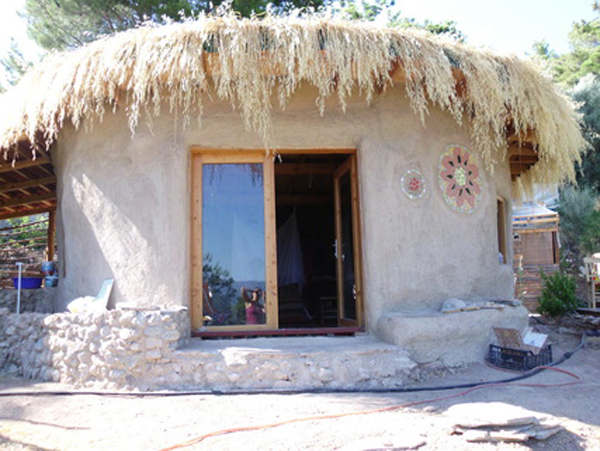
In Turkey, building an Earthbag roundhouse shows how to mix *sustainable architecture* with *low-cost housing solutions*. A team of 12 people worked together, finishing the project with a budget of about $5000. They faced many challenges but proved that *Earthbag construction* is practical and strong.
Overview of the Project
The roundhouse was built to be strong and eco-friendly, using local materials and methods that don’t harm the environment. It ended up being a bit bigger than planned, with a 5.5-meter diameter. The team had 5 men, 5 women, and 5 people from other countries, working with 5 locals. This mix made the building process fun and diverse.
Challenges Faced and Overcome
One big problem was the lack of basic infrastructure, making the foundation hard to prepare. But the team worked together well; they cleared the foundation by mid-morning and filled it with rocks and rubble by afternoon. They also had to deal with different skills among the team and a steep learning curve. Yet, their varied skills helped them overcome these challenges, showing how *sustainable architecture* can be strong and adaptable.
Project Timeline and Costs
The project took six weeks to finish, thanks to careful planning and execution. The total cost was about $5000, proving that *low-cost housing solutions* are possible with limited resources. Despite initial doubts about finishing in a week, the team managed to build the structural core on time.
| Project Aspect | Details |
|---|---|
| Diameter | 5.5 meters |
| Team Size | 12 participants |
| Cost | $5000 |
| Timeline | Six weeks |
The Earthbag roundhouse in Turkey achieved its goals within the budget and timeline. It has lasted over a decade, surviving many earthquakes. This proves the lasting value of *Earthbag construction* and *sustainable architecture*.
Incorporating Earthbag Building into Permaculture Design
Earthbag building and permaculture work together to make sustainable living easier. They blend construction with nature, making homes that are good for the planet. This mix helps people live off the grid while taking care of the environment.
Integration with Other Sustainable Practices
Adding Earthbag building to permaculture means using many green practices together. This makes living eco-friendly and whole.
- Water Harvesting: Earthbag homes can have built-in systems to collect rainwater. This saves water and helps the planet.
- Energy Efficiency: Earthbag walls keep temperatures steady, cutting down on heating and cooling costs.
- Organic Gardening: You can grow food right next to your Earthbag home. This uses permaculture to feed you naturally.
Benefits for Off-Grid Living
Earthbag building is great for living off the grid. It has many benefits for those wanting to be self-sufficient.
- Self-Sufficiency: You can build Earthbag homes with local materials like soil and plastic bags. This saves money and uses less from outside.
- Passive Temperature Control: Earthbag walls keep heat in during the day and release it at night. This keeps your home cozy without using a lot of energy.
- Environmental Impact: Earthbag homes use little wood and natural materials. This protects forests and keeps the environment balanced.
Using Earthbag building and permaculture together makes homes that support off-grid living. They also make the ecosystem around them stronger and more sustainable.
Disaster-Resistance of Earthbag Structures
Earthbag structures are known for their strength against natural disasters. They can handle severe weather, earthquakes, and floods. These buildings are safe and support sustainable living.
Earthbag buildings use bags filled with earth and barbed wire for strength. This design fights against many dangers:
- Earthquake Resistance: During the 2015 earthquake in Nepal, all 55 earthbag buildings stayed strong. Their packed earth and barbed wire made them flexible yet strong.
- Fire and Insect Protection: Earthbag homes are safe from fire and insects. This makes them a secure choice for many.
- Flood Resistance: Earthbag homes are like sandbags for floods. They can be built on high ground and use materials that resist water.
- Wind and Storms: The barbed wire in earthbag structures adds flexibility and strength. This helps them stand up to hurricanes and storms.
| Feature | Earthbag Building | Traditional Building |
|---|---|---|
| Cost per sq. ft. | Rs900 | Rs2500 |
| Local Material Usage | 56% | Varies |
| Keep Local Budget | 86% | Varies |
| Energy Efficiency (R value) | Double that of Concrete | Lower |
Earthbag buildings are strong and smart. They have special features like roof overhangs and reinforced beams. These make them great for fighting hurricanes. For those wanting safe and green homes, earthbag is a top choice for many places.
Earthbag Building for Low-Cost Housing Solutions
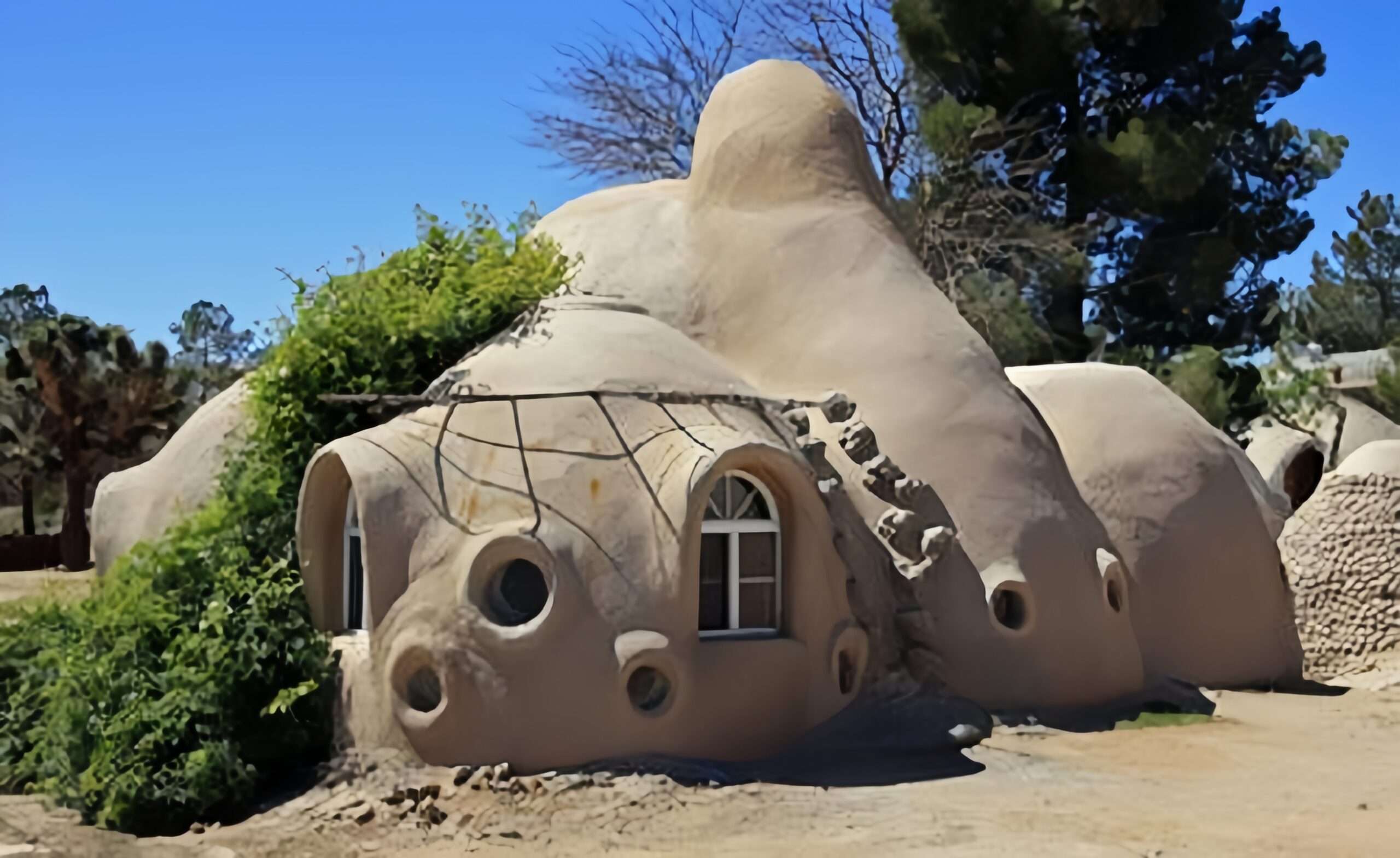
Earthbag building is a great way to make low-cost housing using materials found locally. In Escalante City, they built a shelter with earth mixed with cement and other materials. This made strong structures. The first house, a 45-square meter dome, is now a clinic and took only 30 days to finish.
These homes are not only cheap but also good for the planet. They are part of the trend towards affordable eco-friendly homes. Building one can cost as little as $1,000 USD, helping people in areas hit by disasters. They use materials like soil and bamboo, cutting down on expensive and harmful materials.
The earthbag method is strong and affordable, helping people after disasters and economic hard times. For example, typhoons in the Visayas caused P40 million in damage, leaving many families in debt. Earthbag houses can withstand hurricanes, tsunamis, and earthquakes, offering a safe alternative to traditional homes.
This method also offers a cheap way to expand housing. The first designs include two-bedroom units with a living area and verandah. With over 20 storm-resistant features, these homes can last more than 100 years with care.
Architects, engineers, designers, and housing experts are working together to improve these designs. They make sure the homes are safe and fit the local culture. This approach to green building techniques offers hope for sustainable and affordable housing worldwide.
| Project | Details |
|---|---|
| First Structure | 45-square meter dome house |
| Construction Time | 30 days |
| Construction Cost | As low as $1,000 USD |
| Materials Used | Earth, cement, sand, sugar bagasse, sulfur adobe-strong compound |
| Focus Areas | Durable, eco-friendly, low-cost housing |
| Sustainability | Uses locally available materials, avoids non-sustainable sources |
Conclusion
Earthbag building is a smart way to build sustainably, combining old methods with new eco-awareness. Over time, new techniques like Poured Earth and the Form Free Building System have made it better. These have made it easier and cheaper to build with earthbags.
This method is still hard work but has many benefits. It’s affordable and can stand up to disasters, making it a key part of a green future. Earthbag building is a promising way to build homes that are safe and good for the planet.
Earthbag buildings are strong and can be used in many places. Tests by the U.S. Military Academy showed they can be a cheap way to build strong buildings. They can resist fires and even category 5 hurricanes, making them safe and eco-friendly homes.
These buildings also help make architecture more sustainable. They use materials that don’t harm the environment and don’t release harmful gases. Earthbag building is a great way to build homes that are good for the planet.
Earthbag building is not just good for the environment. It’s also a great way to make affordable homes, especially in warm places. Not many people know about earthbag construction yet, but it could become more popular. With many successful projects around the world, earthbag building is set to be a big part of the green building future.
By promoting earthbag building, we can make homes that are easy to use, flexible, and strong. This shows how we can live in harmony with the earth by building in a sustainable way.

